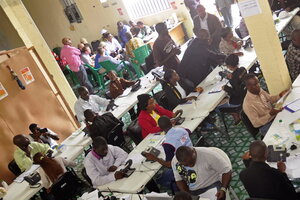Uganda offers lessons on how West Africa can contain Ebola outbreak
So far, the current epidemic has killed nearly 1,000 people in four countries, but it hasn't touched East Africa. Countries like Uganda, which faced a major outbreak in 2000, are prepared with strategies to isolate and treat patients.

Workers are seen inside a Ebola call center, where people can phone to state their concerns about the deadly Ebola virus, in the city of Monrovia, Liberia, Saturday, Aug. 9, 2014. Nearly 1,000 people are known to have died in the latest outbreak.
Abbas Dulleh/AP
JOHANNESBURG, SOUTH AFRICA
On October 7, 2000, Dr. Matthew Lukwiya was sitting in his house in Kampala when his phone rang.
On the line was a doctor at Dr. Lukwiya’s hospital in Uganda's rural Gulu District, 250 miles away. The doctor described with alarm a mysterious disease that had begun killing the hospital’s nurses, who grew feverish and vomited profusely, then bled from their mouths and eyes.
By evening, Lukwiya was in Gulu to examine the patients and scour medical textbooks. The next day, he ordered the creation of an isolation ward in the hospital and telephoned the Ministry of Health in Kampala to confirm what he suspected: His patients were dying of Ebola.
Fourteen years later, as West Africa and the global health community grapple with the worst epidemic ever recorded of the little-understood disease, past outbreaks like Uganda’s offer important — if incomplete — clues about how best to respond. Nearly 1,000 people have died of the disease since March in Guinea, Liberia, Sierra Leone, and Nigeria. On Saturday, Guinea closed its land borders with Sierra Leone and Liberia.
For one, Uganda’s experience shows the importance of moving quickly. Indeed, as soon as laboratory tests confirmed that Lukwiya’s patients had Ebola, the government immediately called a news conference with the World Health Organization (WHO), the US Centers for Disease Control, and major donor nations, asking for assistance.
“In Uganda we have a government with very little shame about infectious disease,” says Roy Mayega, an epidemiologist and lecturer in the school of public health at Makerere University in Kampala. “They are not proud. When there is a crisis, they communicate it quickly.”
Uganda's Health Ministry immediately blanketed radio stations and newspapers with public service announcements explaining the disease and describing proper procedure for burying the dead — in sealed plastic bags. And crucially, the government hired more than 1,000 local villagers from the area around Gulu and sent them door-to-door, looking for Ebola patients hidden by their families, and offering counsel on treatment and burial.
By the time the disease was contained in February 2001, 224 people were dead, including Lukwiya, who died in December 2000 after contracting Ebola. At the time, it was the deadliest case known. But the disease had been stopped – and an institutional memory imprinted for tackling future outbreaks. Indeed, when Ebola erupted again in 2007, it killed only 37 people in Uganda. Another outbreak two years ago killed only 17.
Tri-border challenge
In Sierra Leone, Guinea, and Liberia, however, the Ebola outbreak is an entirely new phenomenon, and with national governments already hobbled by civil war, corruption, and poverty, their health care systems have largely failed to develop a coherent — and coordinated — response.
“One problem is that you have a disease epicenter that is at the crux of three borders,” says Kim Yi Dionne, a professor of African politics at Smith College who has tracked the outbreak closely. “It’s a classic collective action problem: one government could do everything in their power but if the other two are lax and people still cross borders, it won’t matter at all.”
In the absence of muscular governmental reaction, she says, international organizations like the WHO, Doctors Without Borders (MSF), and Samaritan’s Purse have stepped in to fill the void. But they have often struggled to earn the kind of local trust that made community health workers in places like Uganda so effective.
“It’s critical to address local concerns, for instance about how family members should protect themselves around the sick, and about how people are buried,” says Lucille Blumberg, a deputy director at South Africa’s National Institute for Communicable Diseases. “There has to be a solution that’s working for everyone.”
However, despite a flurry of attention around an experimental drug called ZMapp, used on two American Ebola patients with apparent effectiveness, there is no widely-available treatment for Ebola, nor a vaccine for the uninfected. Many living in poor African countries see clinics and hospitals as places where the sick go to die.
At one regional MSF Ebola treatment center in Guinea, for instance, a nurse told the New York Times last month that few of the sick bothered to visit the clinic. “Here, if the people come in, they don’t leave alive,” she said bluntly.
Echoes of HIV/AIDS
The situation in some ways mirrors the early years of HIV's global spread, when many were reticent to seek treatment for a simple reason: nothing worked.
“Once ARVs [antiretrovirals] were available to people, those coming in for testing went way up,” Ms. Dionne says. “When people knew there was something they could do to make themselves better, then they were much more likely to visit a clinic to learn their status.”
The absence of such an effective treatment for Ebola, however, coupled with its wide geographic reach in West Africa, mean this epidemic will likely not be contained for some time. The WHO declared Friday that the outbreak was a “public health emergency of international concern.”
But the organization also noted that this was not a disease mysterious to the global health community — it had been stopped before, so it could be stopped again.

